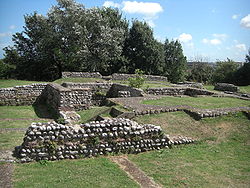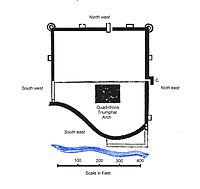Richborough Castle
| Richborough Castle Latin: Rutupiæ | |
|
Kent | |
|---|---|
 Richborough Roman Fort | |
| Type: | Roman fort |
| Location | |
| Grid reference: | TR324602 |
| Location: | 51°17’38"N, 1°19’55"E |
| History | |
| Information | |
| Owned by: | English Heritage |
| Website: | Richborough Castle |
Richborough Castle is the remains of a Roman fort at Richborough close by the east coast of Kent, south of the Isle of Thanet, near Sandwich. The site was once on the cost and a major port. The impressive remains within an stout wall contain the ruins of a Roman Saxon Shore fort, also known as Richborough Fort.
Rutupiae or Portus Ritupis was founded by the Romans after their invasion of Britain in AD 43. The adjacent mouth of the Stour provided a good, sheltered harbour, and in Roman days Rutupiae was the major British port. It was the starting point for the road known today as Watling Street. Additional routes connected Durovernum (Canterbury) with further ports at Dubris (Dover), Lemanis (Lympne), and Regulbium (Reculver). Earthen fortifications were first dug on the site in the 1st century, probably was as a storage depot and bridgehead for the Roman army, but this was soon transformed into a civilian and commercial town.
Later, around the year 277, the early fort was replaced by a Saxon Shore fort. The later fort is believed to have been constructed by the rebel Emperor Carausius].[1]
The site is now under the care of English Heritage.
History
Early Roman days
Richborough is commonly accepted as the landing site for the invasion of Britain by the Emperor Claudius. Evidence is found in the existence of mid-1st century ditches and fortifications on the site, are assumed to have been built to protect their bridgehead and supply depot. However, explicit details on the site of the Claudian invasion have not survived and its location is a matter of scholarly debate.

As the fighting moved north, Rutupiae became an increasingly large civilian settlement. There were temples, an amphitheatre (visible as a hummock in the grass 5 minutes walk from the main site), and a mansio (first built in 100, it was a building that went through several phases, being an inn for visiting officials, bath house and administration building).
As a port, the town always competed with Portus Dubris (modern Dover), about fifteen miles south along the coast. However, Richborough was widely regarded throughout the Roman Empire for the quality of its oysters. They are mentioned as on a par with those from the Italian Lucrine Lake in Juvenal.[2] "Rutupine shore" was used as a common metonymy for Britain in Latin writers.[3]
A major Tetrapylon or quadrifrons triumphal arch is known to have stood straddling Watling Street, beginning the main road from the port towards Londinium. It may have been built in the first century AD to celebrate the final conquest of Britain.
Saxon Shore fort



During the late 3rd century this (by now large) civilian town was remilitarized by its conversion into a Saxon Shore Fort. The Saxon Shore Forts were a series of forts built by the Romans along the Mare Britannicum, on the shores both of Britain and Gaul, to guard against invading Saxon pirates. Construction of the fort here is believed to have started in 277 and completed in 285. This involved the demolition and reuse as spolia of the triumphal arch, and numismatic evidence suggests it occurred during the reign of Carausius.[1]
The fort was 5 acres in area and was surrounded by massive walls, forming an almost perfect square. However, the north and south walls were constructed differently. The north wall was built by separate gangs of labourers, while the south wall seems to have been built as a single unit. This suggests that the north wall of the fort was built sometime after the construction of the south wall. In some places, the walls reached over 25 feet in height, and were built of small ashlar and double-tile courses. The main entrance of the fort was in the west wall. The walls stand to a great height and were of such high quality that they only recently needed repointing.
Though some stone buildings existed in the interior of the fort, most of its buildings seem to have been composed of timber. There existed a central rectangular building built of stone, which was probably the principia (headquarters). Small, stone-built baths were also present at Richborough.[4]
A generation or so after the time of Carausius, the Empire adopted Christianity. An intriguing artefact of this time has been found in Richborough: an object believed to be a hexagonal font. This suggests that the building in whose remains it was found was a church, probably built at the end of the 4th century or at the beginning of the 5th century, but little remains of it.
Roman withdrawal
During the decline of the Roman Empire, Richborough was eventually abandoned by the Romans and after this, the site was occupied by a Saxon religious settlement.
The Triumphal Arch
A major Tetrapylon or quadrifrons triumphal arch was erected straddling Watling Street, the main road from Richborough to London. Its position and size suggest it may have been built to celebrate the final conquest of Britain.[5]
The arch stood 80 feet high with a facade of high quality, Italian granite. Standing as it did between the port and the province, passage through the arch signified formal entry into Britannia.
Only the foundations and mound where the arch stood are still visible.
The Amphitheatre
The Amphitheatre stands away from the fort. Today all that survives is an elliptical hollow measuring 197 feet by 164 feet, which represents the central arena of the Roman theatre, but these earthwrks, after all the ages, remain impressive.
The amphitheatre mound is surrounded by a bank 39 feet wide and rising to a height of about 7 feet. At the narrow ends of the elliptical plan there are two obvious entrances, while on the north-west and south-east sides there are indications of additional entrances or architectural features, possibly towers.
The Church
There exists an unexplained structure at Richborough that is believed to be a font. Today, this structure is almost entirely destroyed. The hexagonal font discovered during the excavations at Richborough suggests that baptisms could have been a function of this church. The church was probably built at the end of the 4th century or at the beginning of the 5th century. It seems plausible that the church was built of wood.[6]
Excavations
Recent Excavations carried out in late 2008 of a section of Roman wall 300 feet long uncovered the original Roman-era coastline along with the remains of a Mediæval dock. The discovery and excavation of the beach itself has pinpointed its geographical relationship to the site's earthworks, proving that the earthworks were a beachhead defence, protecting around 800 yards of coast. The site is now two and half miles inland from the current coastline.[7][8]
In literature and popular culture
Two of Rosemary Sutcliffe's books of the Eagle of the Ninth Chronicles refer to Rutupiae, at the beginning and the end of its Saxon Shore days:
- The Silver Branch set in the days of Carausius describes the new fort: "And above him towered the ramparts of Rutupiae: a grey prow of ramparts raw with newness, from the midst of which sprang the beacon-crested tower of the Light". Carausius seeing the decline of Rome says "If I can make this one province strong - strong enough to stand alone when Rome goes down, then something may have been saved from the darkness. If not, the Dubris light and Limanis light and Rutupiae light will go out. The lights will go out everywhere."
- The Lantern Bearers continuing the theme a century later, begins in Rutupiae and ends with a reference to it. The hero, Flavius, deserts his unit before the last Roman legion leaves Britain from Rutupiae port, and he lights the lighthouse beacon for the last time. The going out of the Rutupiae light is book's metaphor for the end of the Roman Age.
Outside links
| ("Wikimedia Commons" has material about Richborough Castle) |
- Richborough Roman Fort and Amphitheatre - English Heritage
References
- ↑ 1.0 1.1 White, Donald. Litus Saxonicum; The British Saxon Shore in Scholarship and History, page 36. Madison: State Historical Society of Wisconsin for Dept. of History, University of Wisconsin, 1961.
- ↑ Satires of Juvenal 4.141.
- ↑ p. 39, Victoria County History of Kent: Romano-British Kent, 1932. Retrieved on 10 May 2007
- ↑ Johnson, J.S. (1970). "The Date of the Construction of the Saxon Shore Fort at Richborough". Britannia (Society for the Promotion of Roman Studies) 1: 240–248. doi:10.2307/525843. http://links.jstor.org/sici?sici=0068-113X%281970%291%3C240%3ATDOTCO%3E2.0CO%3B2-T.
- ↑ Stillwell, Richard; William Lloyd MacDonald; Marian Holland McAllister (1976). The Princeton Encyclopedia of Classical Sites. Princeton University Press. p. 778. http://www.perseus.tufts.edu/cgi-bin/ptext?doc=Perseus%3Atext%3A1999.04.0006. Retrieved 2007-05-10.
- ↑ Brown, P.D.C (1971). "The Church at Richborough". Britannia (Society for the Promotion of Roman Studies) 2: 225–231. doi:10.2307/525812. http://links.jstor.org/sici?sici=0068–113X%281971%292%3C225%3ATCAR%3E2.0.CO%3B2–O.
- ↑ BBC News - Dig Uncovers Roman Invasion Coast.
- ↑ The Independent - Roman Invasion Beach Found In Kent.
| Saxon Shore forts |
|---|
|
Branodunum • Gariannonum (Burgh Castle • Caister) • Walton Castle • Othona • Regulbium • Rutupiae • Portus Lemanis • Portus Dubris • Anderitum • Portus Adurni |
